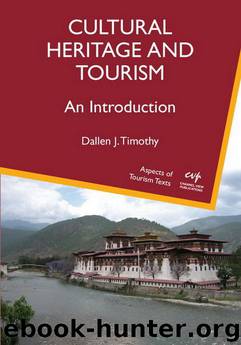Cultural Heritage and Tourism: An Introduction (Aspects of Tourism Texts) by Dr. Dallen J. Timothy

Author:Dr. Dallen J. Timothy [Timothy, Dr. Dallen J.]
Language: eng
Format: mobi
Tags: Cultural Heritage and Tourism
ISBN: 9781845412265
Publisher: Channel View Publications
Published: 2011-08-03T04:00:00+00:00
Plate 10.13 This native Guarani guide at Iguazu Falls, Argentina, contributes to the indigenous narrative of the region’s heritage
Like all forms of planning, interpretive planning is done in a series of steps that help managers formulate plans and make better policy decisions. Procedural planning (see Figure 10.2) is comprised of at least six phases that build on the previous phase. While each circumstance is unique, the planning process includes some common elements regardless of context or situation.
The first step, setting goals and objectives, is vital because it sets the tone for the entire plan and functioning of the interpretive program. Goals and objectives guide the planning process, as all subsequent steps reflect back on the purpose of the plan. Planning goals are typically stated in general terms, while objectives are more specific and describe ways in which the goals might be met. One possible goal for a museum’s interpretive program might be to develop closer relationships with local schools and become a more salient player in a region’s formal education/curriculum. Objectives to help meet this goal could include offering special events that involve schools and school children, or allowing teachers to become involved as actors and interpreters.
Download
This site does not store any files on its server. We only index and link to content provided by other sites. Please contact the content providers to delete copyright contents if any and email us, we'll remove relevant links or contents immediately.
The Brazilian Economy since the Great Financial Crisis of 20072008 by Philip Arestis Carolina Troncoso Baltar & Daniela Magalhães Prates(105542)
International Integration of the Brazilian Economy by Elias C. Grivoyannis(75322)
The Art of Coaching by Elena Aguilar(52196)
Flexible Working by Dale Gemma;(23212)
How to Stop Living Paycheck to Paycheck by Avery Breyer(19567)
The Acquirer's Multiple: How the Billionaire Contrarians of Deep Value Beat the Market by Tobias Carlisle(12112)
Thinking, Fast and Slow by Kahneman Daniel(11798)
The Radium Girls by Kate Moore(11624)
The Art of Thinking Clearly by Rolf Dobelli(9919)
Hit Refresh by Satya Nadella(8859)
The Compound Effect by Darren Hardy(8521)
Atomic Habits: Tiny Changes, Remarkable Results by James Clear(8053)
Tools of Titans by Timothy Ferriss(7818)
Turbulence by E. J. Noyes(7704)
Change Your Questions, Change Your Life by Marilee Adams(7381)
A Court of Wings and Ruin by Sarah J. Maas(7268)
Nudge - Improving Decisions about Health, Wealth, and Happiness by Thaler Sunstein(7247)
How to Be a Bawse: A Guide to Conquering Life by Lilly Singh(7158)
Win Bigly by Scott Adams(6829)
